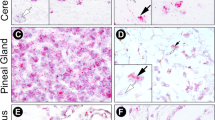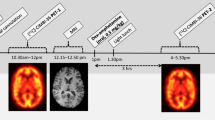Abstract
The undecapeptide substance P is a neurotransmitter candidate in the mammalian central and peripheral nervous system1. Although the distribution of substance P-like immunoreactivity within the central nervous system (CNS) is well established2, the recent identification and autoradiographic localization of specific substance P-binding sites has revealed numerous areas of mismatch between peptide levels and numbers of such sites3–6. Previous studies have shown that substance P stimulates the hydrolysis of inositol phospholipids in peripheral tissues and in the hypothalamus7,8, probably through stimulation of a polyphosphoinositide-specific phospholipase C (refs 9–11). Inositol phospholipid hydrolysis has been implicated in the mobilization of cytosolic calcium following receptor activation in several neurotransmitter and hormonal systems12. We have therefore investigated the distribution of 3H-labelled substance P binding sites within various rat brain regions and correlated this with the rate of substance P-induced hydrolysis of inositol phospholipids in the same areas of the CNS. We found that the rate of inositol phospholipid hydrolysis was proportional to the number of binding sites specific for 3H-substance P, suggesting that binding sites revealed by 3H-substance P autoradiography correspond to functional substance P receptors.
This is a preview of subscription content, access via your institution
Access options
Subscribe to this journal
Receive 51 print issues and online access
$199.00 per year
only $3.90 per issue
Buy this article
- Purchase on Springer Link
- Instant access to full article PDF
Prices may be subject to local taxes which are calculated during checkout
Similar content being viewed by others
References
Jessell, T. M. Handbk Psychopharmac. 16, 1–105 (1983).
Ljungdahl, A., Hökfelt, T. & Nilsson, G. Neuroscience 3, 861–943 (1978).
Cascieri, M. A. & Liang, T. J. biol. Chem. 258, 5158–5164 (1983).
Torrens, Y., Beaujouan, J. C., Viger, A. & Glowinski, J. Naunyn-Schmiedebergs Archs Pharmak. 324, 134–139 (1983).
Viger, A., Beaujouan, J. C., Torrens, Y. & Glowinski, J. J. Neurochem. 40, 1030–1039 (1983).
Quirion, R. et al. Nature 303, 714–716 (1983).
Hanley, M. R., Lee, C. M., Jones, L. M. & Michell, R. H. Molec. Pharmac. 18, 78–83 (1980).
Watson, S. P. & Downes, C. P. Eur. J. Pharmac. 93, 245–253 (1983).
Creba, J. A. et al. Biochem. J. 212, 733–747 (1983).
Berridge, M. J. Biochem. J. 212, 849–858 (1983).
Downes, C. P. & Wusteman, M. M. Biochem. J. 216, 633–640 (1983).
Berridge, M. J. Biochem. J. 220, 345–360 (1984).
Mantyh, P. W., Maggio, J. E. & Hunt, S. P. Brain Res. (in the press).
Hunt, S. P. & Mantyh, P. W. Brain Res. 291, 203–217 (1984).
Berridge, M. J., Downes, C. P. & Hanley, M. R. Biochem. J. 206, 287–294 (1982).
Author information
Authors and Affiliations
Rights and permissions
About this article
Cite this article
Mantyh, P., Pinnock, R., Downes, C. et al. Correlation between inositol phospholipid hydrolysis and substance P receptors in rat CNS. Nature 309, 795–797 (1984). https://doi.org/10.1038/309795a0
Received:
Accepted:
Issue Date:
DOI: https://doi.org/10.1038/309795a0
This article is cited by
-
Subchondral bone microenvironment in osteoarthritis and pain
Bone Research (2021)
-
Genetic and pharmacological antagonism of NK1 receptor prevents opiate abuse potential
Molecular Psychiatry (2018)
-
Nuclear Localization of SP, CGRP, and NK 1 R in a Subpopulation of Dorsal Root Ganglia Subpopulation Cells in Rats
Cellular and Molecular Neurobiology (2006)
-
Further studies on the mechanism of action of substance P in rat brain, involving selective phosphatidylinositol hydrolysis
Neurochemical Research (1995)
Comments
By submitting a comment you agree to abide by our Terms and Community Guidelines. If you find something abusive or that does not comply with our terms or guidelines please flag it as inappropriate.



